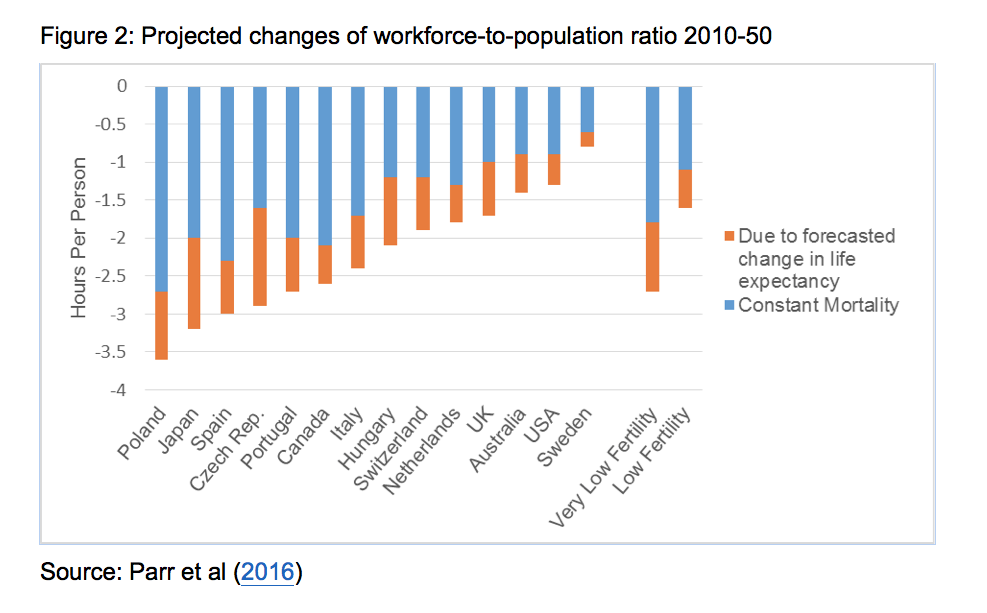Ongoing increases in life expectancies may slow the growth of living standards in developed countries. One reason for this is that reductions in mortality rates, which these days are generally greater in the older ages, lower the proportion of the population who are active in the labour force. However, the extent of future life expectancy increase and its effect on the share of population in the labour force will vary considerably between countries.
A recent study by Parr et al. (2016) considers the prospects for 14 countries; Australia, Canada, Czech Republic, Hungary, Italy, Japan, the Netherlands, Poland, Portugal, Spain, Sweden, Switzerland, UK, and USA. It combines a new method which generates relatively accurate and coherent forecasts of future death rates (Li 2013, Li et al. 2016), and a new method for evaluating the effects of projected population trends on living standards (Parr and Guest 2014).
Recent and forecasted future trends in life expectancy
Life expectancy gains have varied from country to country. For both sexes, Portugal had the fastest increase in life expectancy at birth between 1970 and 2010, much of which was due to reductions in infant mortality. Japanese life expectancies increased greatly over this period, and Australia, Italy, Switzerland, Spain, and the UK also made relatively large gains. Following stagnation or even – for males – declines over 1970-90, life expectancy at birth increased dramatically after 1990 in the Czech Republic, Hungary and Poland. In contrast, throughout 1970-2010 the increases in life expectancy at birth for the Netherlands, Sweden, USA and Canada were relatively slow.
The extent of future gains in life expectancy is likely to vary considerably between countries. For both sexes the greatest increases in life expectancy at birth over 2010-50, forecast by Parr et al (2016), are for Japan, followed by the three East-Central European countries (Czech Rep., Hungary and Poland), Australia and the UK (Figure 1). The forecasted gains in life expectancy at birth are relatively small for the Netherlands, USA, Canada and Sweden for both sexes, and for Spanish females. In all countries, the increase in life expectancy at birth is expected to be greater for males than for females, continuing the recent trend.
An ageing ‘double whammy’
Increasing life expectancy is not the only trend which causes population ageing: lower fertility also increases the proportion in the older ages relative to that in the younger ages. For both males and females, the future life expectancy increases forecast by Parr et al. (2016) tend to be greater in the countries with very low fertility rates (Czech Republic, Hungary, Italy, Japan, Poland, Portugal, Spain and Switzerland). The projected ageing of populations over 2010-2050 is more uneven between countries because two factors (low fertility and increasing life expectancy), each of which individually would promote population ageing, tend to coincide in the same countries.
Future changes to the population supported per worker
Population ageing will reduce the average hours worked per person across the total population if working patterns of people within different age ranges remain unchanged (Figure 2). Contrary to a popular belief which equates population ageing with increasing life expectancy, in all the countries Parr et al. (2016) studied, most of the projected reduction in hours worked per person would occur even if there were no future increase in life expectancy, assuming fertility rates and net international migration also remain unchanged (Figure 2).
The prospects facing different developed countries vary widely. The decreases in per person hours worked tend to be greater in countries with very low fertility rates, and greatest of all in Poland and Japan. These patterns reflect the fact that very low fertility causes rapid population ageing (even more so in Japan and Poland – which have net outmigration) and that large gains in life expectancy are also forecast for these countries.
By maintaining a constant immigration flow over time, some countries would be able to stabilise previously declining trend for annual numbers of births. Whilst before 2050 the populations of the Czech Republic, Hungary, Italy and Portugal face the prospect of rapid ageing, over a longer period of time a partial rejuvenation of these populations could occur if they were to maintain their current immigration levels.
The cost of living longer depends on the broader demographic picture
Increasing life expectancy is a welcome trend which allows people to enjoy life for longer. The adverse effect of this trend on future living standards could be more than offset by the effects of increases in workforce participation and productivity. Increases in the official normal ages for eligibility for state pension have been planned in most developed countries, and justified by forecasted longevity gains (OECD 2015). However, equating the effects of population ageing with those of forecasted gains in life expectancy, which appears to be widespread in public debates, is misplaced.
The effect of future increases in life expectancy on living standards is likely to vary widely between countries and will depend on their fertility and migration levels, and hence age profiles, as well as on the extent of future mortality. Thus for example, in Australia, which has a younger population than most other developed countries, only relatively modest changes in workforce participation would be needed to compensate for the effect of its large forecast gains in life expectancy.
References
Li, J., Tickle, L. and Parr, N. (2016) An evaluation of the Poisson common factor model for projecting mortality jointly for both sexes using data from multiple populations. Journal of Population Research 33(4): 333-360.
OECD (2015) Pensions at a Glance 2014: OECD and G20 Indicators. Paris: OECD Publishing.
Parr, N. and Guest, R. (2014) A method for socially evaluating the effects of long run demographic paths on living standards. Demographic Research 31(11):275–318.
Parr, N., Li, J. and Tickle, L. (2016) A Cost of Living Longer: Projections of the Effects of Prospective Mortality Improvement on Economic Support Ratios for Fourteen More Advanced Economies. Population Studies. 70(2): 181-200.




